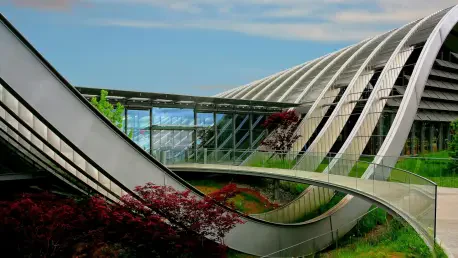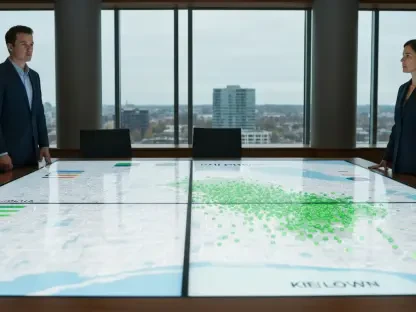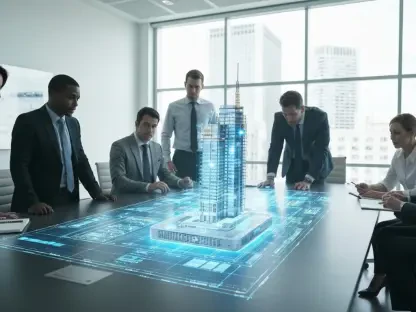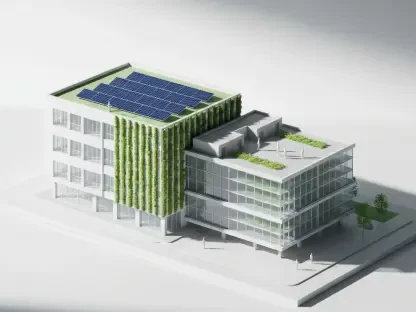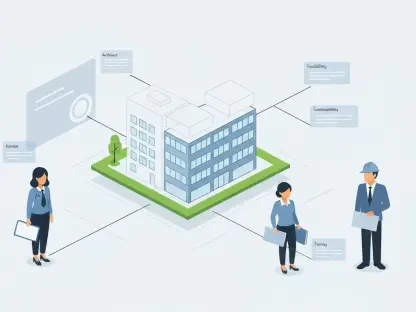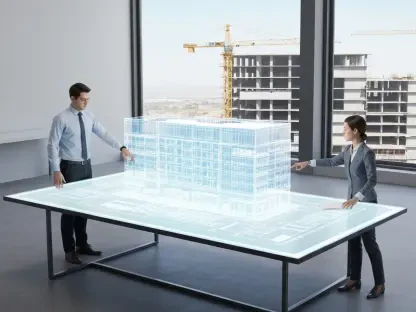As the push toward sustainable living gains traction, the construction industry in the United States is undergoing a fundamental transformation. The focus is on eco-friendly building practices designed to minimize the environmental impact of residential development. These innovations are both technological and cultural, signifying a societal shift toward valuing sustainability as a cornerstone of modern life. Companies are integrating advanced building technologies and strategies that support energy efficiency and sustainability, marking significant progress. This movement is particularly highlighted around events like Earth Day, a time when successes in sustainable building are showcased. As a testament to their potential, these practices are making significant inroads into mainstream home construction, driving developments that promise to redefine conventional approaches to building and residence.
Modern Innovations and Success Stories
The advent of innovative technologies in the home construction industry is reshaping the landscape, with key players like ICON at the forefront, revolutionizing how homes are built. ICON’s use of advanced 3D printing methods has become a hallmark of modern construction, setting new benchmarks for efficiency and environmental responsibility. This technology allows for extremely precise and resource-efficient building processes, producing structures that stand out for their superior environmental performance. Bungane Mehlomakulu, director of building science and performance at ICON, emphasizes the outstanding thermal resistance and energy efficiency of their 3D-printed wall systems. These systems eclipse traditional construction methods, offering greater airtightness and insulation, significantly reducing energy requirements for heating and cooling. This is not just a step forward in construction; it’s a leap toward a more sustainable future.
The successful implementation of these innovative techniques is already visible in various projects, sparking broader change across the industry. ICON’s achievements serve as a blueprint for others, clearly demonstrating the tangible benefits of adopting sustainable practices. Their partnership with major builders showcases how the integration of new technologies can not only meet but exceed current environmental standards. This approach represents a growing trend where sustainability is not an afterthought but a primary factor in design and construction strategies. The stories emerging from such success illuminate a path forward for the industry, providing both inspiration and a practical framework for widespread adoption of sustainable building practices.
The Largest 3D-Printed Community
One of the groundbreaking achievements in the realm of sustainable construction is ICON’s collaboration with Lennar on a large-scale residential project. Situated in Wolf Ranch, Texas, this initiative is the world’s largest collection of 3D-printed homes, setting a new standard for sustainable community development. The project exemplifies how new technologies can harmonize with renewable energy practices, paving the way for a transformative approach to eco-conscious living environments. Each home in this innovative community is outfitted with solar energy systems capable of meeting approximately 80% of electrical demands, significantly lowering Home Energy Rating System (HERS) scores and outstripping typical home efficiencies.
This remarkable development highlights a significant paradigm shift, demonstrating how communities can be constructed with reduced carbon footprints and higher sustainability indices. The success of ICON and Lennar’s endeavor has not only garnered attention but also inspired other developers to consider similar sustainable strategies in their projects. By proving that greener communities can be realized through a combination of technology and renewable resources, these new approaches promise to revolutionize the residential construction industry. The long-term implications of such projects are profound, indicating a movement toward sustainable urban planning and development that prioritizes the health of the environment alongside economic and social growth.
Extending Sustainable Designs
ICON’s initiatives extend beyond single projects, as evidenced by their ongoing work in the Wimberley Springs and Mueller communities in Austin, Texas. These endeavors further reflect their commitment to developing environmentally sustainable housing, incorporating key energy efficiency and performance standards. Through the application of ENERGY STAR certification and Austin Energy’s Green Building program, ICON ensures that their designs align with high environmental benchmarks, showcasing how construction can integrate seamlessly with its natural surroundings. Their use of CarbonX, a low-carbon printable material, underscores this dedication to reducing ecological impacts and adhering to strict sustainability criteria.
Further enhancing their commitment, ICON’s designs incorporate climate-responsive features such as solar orientation and passive shading through strategic architectural elements like roof overhangs. These features are not merely aesthetic but serve practical purposes, significantly boosting energy efficiency and environmental responsibility. The employment of high-efficiency air conditioning systems and other eco-friendly technologies within these homes further supports their role as leaders in green residential construction. Both communities serve as living laboratories where sustainable living solutions are developed and tested, providing valuable insights into the challenges and successes of energy-focused construction.
Diverse Eco-Friendly Home Builders
In the broader sphere of sustainable construction, other builders are also making remarkable strides. Stone Martin Builders is a key player in this landscape, notably their efforts in Alabama and Georgia, where their ENERGY STAR-certified homes showcase the potential of environmentally conscious building methodology. These homes are constructed to exacting standards, ensuring they provide verifiable energy savings and reduced environmental impact over time. Through high-performance windows, advanced insulation systems, and energy-efficient heating and cooling, Stone Martin Builders provides homeowners with durable, cost-saving, and sustainable living options.
Similarly, the wave of eco-friendly minimalism is being championed by firms like Clever Tiny Homes in California. Specialized in the burgeoning trend of tiny homes, Clever Tiny Homes advocates for designs that minimize material use and environmental disturbance, promoting a sustainable lifestyle that resonates with modern values of simplicity and efficiency. These homes are factory-built, reducing waste and ensuring sustainable use of resources, aligning with the broader aspirations of reducing residential ecological footprints. Such initiatives are complemented by companies like Better Place Design & Build, which focus on accessory dwelling units (ADUs), presenting compact yet efficient living spaces, offering another dimension of sustainable urban living without the expansiveness of suburban sprawl.
Benefits of Smaller Footprints
The drive for more compact, efficient living spaces is further explored through the potential of accessory dwelling units (ADUs). As housing costs rise and urban spaces become more crowded, ADUs offer a compact and sustainable alternative. Bar Zakheim, CEO of Better Place Design & Build, emphasizes the numerous advantages of these smaller footprints, which provide adequate living arrangements with substantially reduced environmental impact. The benefits of ADUs are manifold; they not only offer economic advantages but also encourage community-centric living, which can positively influence neighbor interactions and the overall neighborhood aesthetic, fostering a sense of unity and shared responsibility for sustainability.
However, the transition to smaller, more sustainable living faces several hurdles, notably regulatory challenges and local opposition. Zoning laws and community resistance pose significant barriers to the widespread acceptance of ADUs and tiny homes. Despite the clean environmental promises they hold, these homes are often mired in complex bureaucratic processes that can hinder their adoption. Cities and municipalities must reconcile these challenges with the need for sustainable housing alternatives, suggesting that concerted efforts from policymakers and community leaders are crucial in paving the way for broader acceptance and implementation of these environmentally-friendly housing options.
Sustainable Renovations and Retrofits
The narrative of sustainability extends into existing homes through targeted renovations and retrofits that enhance energy efficiency and reduce resource consumption. Companies like We Buy Doors in Florida specialize in this area, focusing on breathing new life into older constructions with modern, sustainable solutions. Energy-efficient renovations are critical in addressing the environmental impact of older buildings, which often fall short of current energy and ecological standards. By integrating smart technologies, such as energy-efficient windows, insulation, and sustainable materials, these renovations promise to considerably cut down on energy costs and resource usage.
Solar panel systems are another pivotal element of these sustainable renovations, offering homeowners significant reductions in electricity expenses while boosting property values. Smart thermostats and water-conserving fixtures further contribute to resource conservation, making these retrofits not only ecologically beneficial but also economically sound investments. These efforts demonstrate that sustainability is not confined to new builds; existing properties have substantial potential to be transformed into eco-friendly homes with thoughtful investments in sustainable materials and technology. These solutions not only enhance living conditions but also support broader environmental goals by minimizing the ecological footprint of established residences, making sustainability accessible and practical for a greater segment of homeowners.
Challenges and Opportunities
Despite the promising advances in sustainable construction, several challenges remain that need to be addressed to fully harness its potential. Among the most significant is the higher initial cost of green materials and technologies, which can deter both builders and prospective homeowners from pursuing sustainable building projects. These upfront expenses, often 10-20% higher than traditional construction methods, create financial barriers, especially in markets or regions where housing affordability is already a concern. Nonetheless, the long-term savings that result from lower energy usage and increased property values often justify such investments, but the return on investment may not be immediately apparent to everyone involved.
Local building codes and the availability of financing options also present challenges to the widespread adoption of sustainable practices. Inconsistent or outdated regulations can complicate efforts to incorporate new technologies into building plans, while limited financing alternatives for green projects can discourage construction entities. However, cities with favorable policies can provide a blueprint for wider acceptance and implementation, encouraging other regions to adapt and facilitate the growth of sustainable building practices. As awareness of environmental issues continues to rise, there is potential for overcoming these obstacles and seizing the opportunities they present, ultimately leading to broader implementation of eco-friendly housing solutions.
Trends in Green Building
Emerging technologies in home construction are drastically changing the field, with pioneers like ICON leading the way in transforming home-building methods. ICON’s pioneering use of cutting-edge 3D printing techniques is setting new standards for both efficiency and environmental consciousness. This technology is remarkable for its precision and resource efficiency, yielding structures that excel in environmental performance. Bungane Mehlomakulu, ICON’s director of building science and performance, emphasizes the impressive thermal resistance and energy efficiency of their 3D-printed walls. These walls far surpass traditional methods by offering enhanced airtightness and insulation, significantly reducing energy needs for heating and cooling. This isn’t just progress in construction; it’s a major leap towards a sustainable future.
The success of these innovative methods is already evident in various projects, prompting significant industry shifts. ICON’s work serves as a model, clearly illustrating the benefits of sustainable practices. Collaborations with major builders highlight the potential to exceed current environmental standards, focusing keenly on sustainability in design and construction. The tales of success emerging from these initiatives illuminate a forward path, offering both motivation and a practical guide for adopting widespread sustainable building practices.
